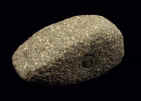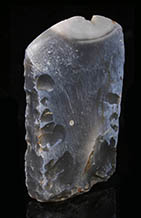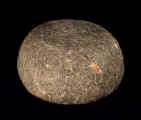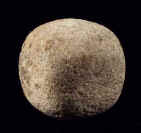The Neolithic period was the last phase of Stone Age and is characterized by the use of ground or polished stone weapons, tools and implements.The Neolithic tools & weapons: axes and hammers, adzes and chisels, knives and scrapers, sickle and hoe were used for cereal cultivation and animal domestication.The Chalcolithic (or Eneolithic) era marks a transition period to the Bronze Age with the introduction of Bronze metallurgy. In Europe the arrival of bronze tools and weapons did not play a noticeable role in production for household or military craft. Stone still was used for implements or battle weapons. Many of them were multi-purpose tools that could be used as hoes, working axes, adzes, chisels and battle axes depending of the method of fastening the haft.
1382SA
Neolithic to early Bronze Age
Boat shaped battle axe
Europe, II Millennium B.C.
Made of dense gray-brown diorite. Boat-shaped with a blade higher than a butt. Middle part with vertical shaft-hole. Blade and shaft-hole are finely polished. Drilled from both ends, leaving horizontal parallel grooves, different diameters of top and bottom.
Intact. L. 6.2" (15.6 cm), H. 2" (4.8 cm).
$ 800
1301SA
Eneolithic
Flint axe, Europe
2800-2500 B.C.
Light grey flint of trapezium shape with slightly convex sides, rectangular cross-section, convex cutting edge, finely polished blade. L. 5.2" (13.3 cm).
- Klochko V. I., Weaponry of societies of the Northern Pontic culture circle: 5000-700 BC. Poznań : Adam Mickiewicz University, Institute of Eastern Studies, Institute of Prehistory, 2001, Fig. 18: 4
$ 350
1392SA
Early Bronze Age period
Ceremonial axe
Catacomb culture, Europe
2500-1900 BC
Made of dense brown stone, divided by smooth notches into blade with hook shaped cutting edge, wide middle part with vertical shaft-hole and a spherical butt. Top plane slightly concave, the bottom one is flat. Finely polished all over. Drilled from both end, horizontal parallel grooves are polished a well, different diameters of top and bottom.
Intact. Length 4.2" (10.6 cm), Height 2.4” (6.1 cm) Width 2.4” (6 cm)
Blade is smoothly rounded, excluding its use as functional cutting tool. It’s been suggested by scholars that it was either a parade weapon, insignia of power of military superiors.
For similar published archaeological examples see:
- Klochko V. I., Weaponry of societies of the Northern Pontic culture circle: 5000-700 BC. Poznań : Adam Mickiewicz University, Institute of Eastern Studies, Institute of Prehistory, 2001, Fig. 47: 1 , 2.
$ 900
257SA
Neolithic Flint axe head
Globular Amphora culture
Europe, III Millennium B.C.
Dark gray flint with white dotted inclusions. Trapezium shape with rectangular cross-section, slightly concave sides, convex cutting edge, finely polished blade.
L. 6.6" (16.8 cm).
For similar published archaeological examples see:
- Klochko V. I., Weaponry of societies of the Northern Pontic culture circle: 5000-700 BC. Poznań : Adam Mickiewicz University, Institute of Eastern Studies, Institute of Prehistory, 2001, Fig. 18: 1, 2
$ 350
263SA
Bronze Age
An important stone hammer-axe
The Trzciniec culture
Europe, II Millennium B.C.
Gray granite. Wedge-shaped with rectangular cross-section, convex cutting edge. Incomplete socket hole.
Very important piece from a scientific point of view, rare opportunity to study ancient methods of tubular drilling.
Length 3.9" (9.9 cm), Height 1.8 (4.8 cm).
For published examples see: C. Berezanskaya, E. Tsvek, 1994, Remeslo Epohi Eneolita-Bronzi na Ukraine, p. 35
$ 500
818SA
Eneolithic stone adze-axe
South-Eastern Europe
2800-2500 B.C.
Gray-brown granite. Diamond-shaped with rounded corners, rectangular cross-section; butt is emphasized, horizontal cutting edge, perpendicular to the axis of the hole. Drilled from both ends, leaving horizontal parallel grooves. Ground finish. L. 4.5" (11.4 cm), H. 1.3 (3.3 cm).
$ 425
847SA
Neolithic - early Bronze Age
Battle axe,
Corded Ware culture, Europe
2500-1900 B.C.
Black dense stone. Wedge-shaped with rectangular cross-section, convex cutting edge; butt is emphasized, with oval face. Drilled from one end, conical opening. Finely polished all over. L. 3.4" (8.6 cm), H. 1.5" (3.8 cm).
- Klochko V. I., Weaponry of societies of the Northern Pontic culture circle: 5000-700 BC. Poznań : Adam Mickiewicz University, Institute of Eastern Studies, Institute of Prehistory, 2001, Fig. 44: 7; Fig.50
$ 450
1307SA
European Early Bronze Age
Corded Ware culture
Flint axe head 2500-1900 B.C.
Light grey flint of trapezium shape with slightly convex sides, rectangular cross-section, convex cutting edge, finely polished blade. L. 4.6" (11.6cm).
$ 275
820SA
Neolithic stone axe head
South-Eastern Europe
III Millennium B.C.
Dense dark greenish-grey stone of triangular shape with pointed down butt and biconvex cross-section, convex cutting edge, finely polished.
Intact Length 3.9" (9.9 cm), thickness 3.0 cm
$ 300
1315SA
Neolithic to early Bronze Age
Flint scraper, Europe
III Millennium B.C.
Made from flint flake, triangular prism in form with retouch along perimeter.
L. 1.4" (3.5 cm), H. 0.3" (0.7 cm).
$ 45
1316SA
Neolithic to early Bronze Age
Flint tool, Europe
III Millennium B.C.
Made from flint flake, scoop form with retouch along one side.
L. 1.8" (4.5 cm), H. 0.4" (1 cm).
$ 45
1317SA
Eneolithic
Flint hooked tool, Europe
III Millennium B.C.
Made from flint flake, droplet in form with retouch along one side and hooked point.
L. 1.6" (4.0 cm), H. 0.4" (1 cm).
$ 45
258SA
Neolithic to early Bronze Age
Flint axe, Eastern Europe
III-II Millennium B.C.
Dark gray flint with white dotted inclusions, trapezium shape with rectangular cross-section, convex cutting edge, polished. L. 4.7" (12 cm).
$ 275
1396SA
Neolithic to early Bronze Age
Flint adze axe
Globular Amphora culture
Europe, 2800-2500 B.C.
Dark brown semi-transparent flint, trapezium shape with rectangular cross-section, slightly convex sides and cutting edge, finely polished.
Intact. Lenght 3.2" (8.1 cm), Height 0.7" (2 cm), Width 2.3” (5.8 cm).
For similar published archaeological examples see:
- Klochko V. I., Weaponry of societies of the Northern Pontic culture circle: 5000-700 BC. Poznań : Adam Mickiewicz University, Institute of Eastern Studies, Institute of Prehistory, 2001, Fig. 44: 7; Fig. 18: 5
$ 250
1394SA
Bronze Age
Flint sickle, Europe
II Millennium B.C.
Light gray flint. Convex blade with one end tapering to a point and opposed one to the stud to be inserted to a handle. Light typical polish as a result of working with grain-crops.
Length 5.4" (13.7 cm), thickness 0.5” (1.4 cm). Intact, minor ancient losses along the edge.
For similar published archaeological examples see: C. Berezanskaya, E. Tsvek, 1994, Remeslo Epohi Eneolita-Bronzi na Ukraine, p. 35, Fig. 10
$ 225
1395SA
Neolithic to early Bronze Age
Flint sickle, Europe
II Millennium B.C.
Dark semitransparent flint. Narrow convex blade. Highly polished surface from extensive use. Tip of the blade is lost, otherwise intact.
Length 5.1" (13 cm), thickness 0.5” (1.0 cm).
$ 275
846SA
Neolithic flint chisel
Europe, II Millennium B.C.
Light grey flint with rectangular top and bottom, biconvex sides, square cross section straight cutting edge, working surface is finely polished.
Length 3. 4" (8.6 cm).
For similar published archaeological examples see:
- Klochko V. I., Weaponry of societies of the Northern Pontic culture circle: 5000-700 BC. Poznań : Adam Mickiewicz University, Institute of Eastern Studies, Institute of Prehistory, 2001, Fig. 18: 3
$ 175
825SA
Neolithic to early Bronze Age
Stone hoe, Europe
2500-1900 B.C.
Massive gray grained stone. Each plane is a convex triangle with round corners and sides. Both cutting edges perpendicular to each other. Drilled from one end, large conical openings. Ground rough finish. L. 5" (12.7 cm), W. 3.2 (8.1 cm), H. 3.2 (8.1 cm).
$ 275
826SA
Early Bronze Age
Stone planer, Europe
II Millennium B.C.
Made of dense dark stone, oval in cross-section, with grooves and facets for convenient grasping, flat polished base-plane. This planer was used for surfacing and flattening leather. L. 2" (5.1 cm), W. 1.6 (4.1 cm), H. 1.8 (4.6 cm).
$ 375
265SA
Neolithic to early Bronze Age
Grinding stone, Europe
XXI - XVII century B.C.
Light gray, cube shaped grinding stone. H. 1.7" (4.3 cm).
For similar published archaeological examples see: C.Berezanskaya, E.Tsvek, 1994, Remeslo Epohi Eneolita-Bronzi na Ukraine, Kiev, Naukova Dumka, 1994, Fig. #3
$ 150
264SA
Early Bronze Age Grinding stone
Katacomb Culture, Europe
XXI - XVII century B.C.
Light gray, disc-shape grinding stone with removed segments for finger grip. D. 3" (7.6), H. 1.2" (3 cm).
For similar published archaeological examples see: Soviet Archaeology, Academy of Science of USSR, Moscow, 2-1989, pg. 145, #3.
$ 250















































